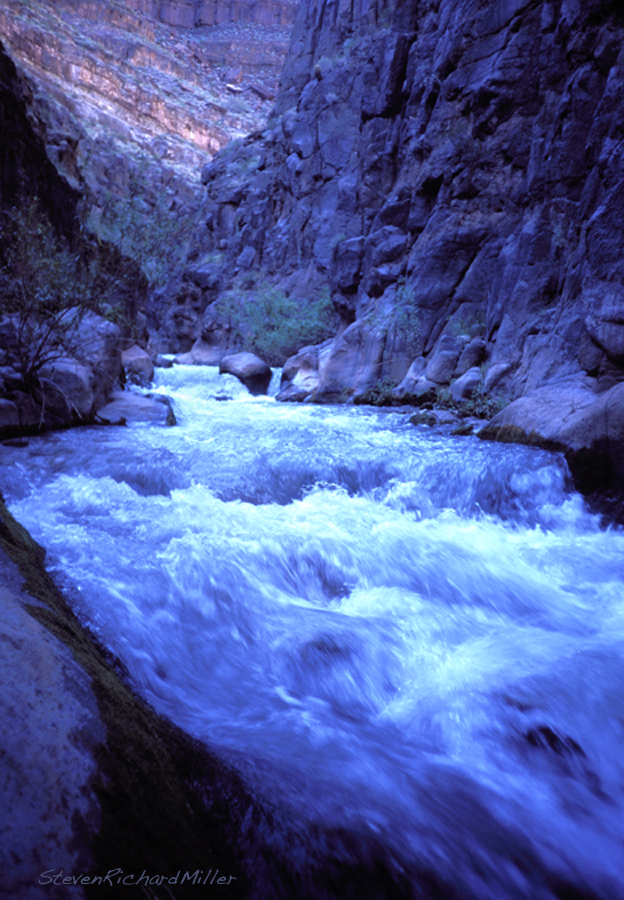Tapeats Creek! It’s a crystal-clear trout stream fed by springs that issue from below the North Rim, one of which is the spectacular Thunder River Spring which shoots out of a cave in a limestone cliff.

Tapeats Creek. Camping is no longer allowed at the mouth. The lower camp is considerably less desirable (see below).

At the mouth of Tapeats Creek, view downstream of the diabase layer, capped by the Bass Limestone and Tapeats Sandstone
The diabase mentioned above was first encountered at the foot of Bedrock Rapid. It is an intrusive rock that squeezed in between two members of the Grand Canyon Supergroup – the Bass Limestone above and the Hotauta Conglomerate below. It is a “sill” – meaning it is a horizontal layer.

Tapeats Creek, lower camp. Watch out for abrasion from your boats moving back and forth against the rocks.
Tapeats Creek exits its lower gorge a short ways upstream from the mouth. The trail to the upper valley climbs straight uphill near here, until it reaches the layered Bass Limestone. Look for an exposure of asbestos as this trail reaches the top of the diabase. This asbestos is the product of “contact metamorphism” – when the molten diabase made contact with the Bass Limestone, it turned serpentine inclusions in the limestone into asbestos.

Tapeats Creek, lower gorge, wide-angle view. The trail contours along the limestone ledges seen here.

The Grand Canyon Supergroup is present in the upper valley. A barrel cactus is seen in the reddish Hakatai Shale, and the purplish cliff is the Shinumo Quartzite.

The Bass Limestone is seen in the foreground, with Shinumo Quartzite on the right and the Redwall Limestone beyond
You get to see a lot of the Grand Canyon Supergroup on your hike up Tapeats Creek – from the Bass Limestone to the Hakatai Shale to the Shinumo Quartzite. Notice, in the photo above, the tilted layers of the Shinumo Quartzite that are capped by the horizontal Tapeats Sandstone. The top of the Shinumo is an “erosional surface”, where, in this case, erosion leveled it out perfectly. Afterwards, the Tapeats was deposited along the shores of an inland sea atop it. Tapeats Creek is the “type locality” for the Tapeats Sandstone – the place where it was first named.
Thunder River is fed by snowmelt that percolates into the limestone beneath the Kaibab Plateau of the North Rim, running downhill through a cave system, finally to exit in the Muav Limestone. Other springs feed the upper portion of Tapeats Creek, and such springs are found in other drainages. Thunder River drops in volume throughout the summer, and the cave that it exits can be entered when the water is low. This cave can be followed quite a ways back.
Many river runners continue to hike beyond the waterfalls of Thunder River, arriving eventually at Deer Creek, the next drainage downstream on the Colorado.

A downstream telephoto view from the mouth of Tapeats Creek. On the left is the dark diabase rock, next is the yellowish Muav Limestone and the main wall of Redwall Limestone.
Note: This and prior posts on the subject of running the Colorado River in the Grand Canyon are excerpted from my iBook: “The Grand, the Colorado River in the Grand Canyon, a Photo Journey and Visual Guide, 2nd. edition”. The book costs $5.99 and is available from the iTunes Store, using this link: https://itunes.apple.com/us/book/the-grand/id672492447?ls=1



























Bravo!
LikeLike